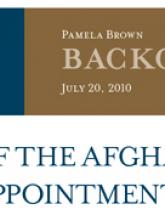 |
 |
Analysis of Afghan Defense Appointments

Click here to download Backgrounder: Analysis of Afghan Defense Appointments
Building a legitimate and effective Afghan National Army (ANA) supported by reliable civilian leadership in the Afghan Ministry of Defense (MoD) is a prerequisite to Afghanistan’s enduring stability. A reshuffle of senior ANA and MoD officials in late June 2010 was thus a noteworthy development with ramifications for the United States and ISAF’s long term goals for the Afghan state.
The June ANA and MoD appointments follow the removal of Afghanistan’s Minister of the Interior (MoI) Hanif Atmar and National Directorate of Security (NDS) chief Amrullah Saleh. President Karzai stated that he had lost confidence in Atmar and Saleh following a security breach at the Peace Jirga, but many sources point to preexisting tension between Karzai and the two men as the real cause of the resignations. Both men had challenged Karzai on his plans to reconcile and reintegrate Taliban fighters. As one analyst suggested, the removal of Atmar and Saleh “speaks volumes about the growing paranoia in the palace about the loyalties of those who have been central to the Karzai administration for the last several years."
When taken together, this reshuffle of the leadership of Afghanistan’s security forces is one of the most significant political developments in Afghanistan this year. The Army and MoD appointments occurred in the context of increasing ethnic factionalism, both in the ANA and in Afghan politics more generally. Recent reporting indicates that Karzai has failed to check factionalism within the army and the MoD and that some senior military commanders act on behalf of the powerbrokers who back them, rather than working for the long term institutional strength of the ANA.